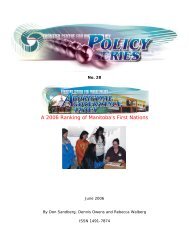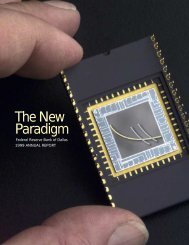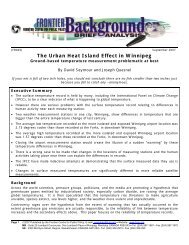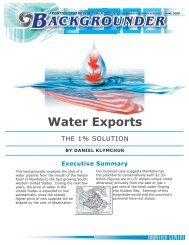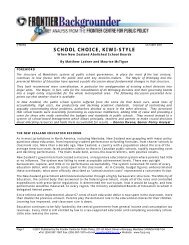The New Paradigm - Federal Reserve Bank of Dallas
Create successful ePaper yourself
Turn your PDF publications into a flip-book with our unique Google optimized e-Paper software.
11<br />
Exhibit 6<br />
<strong>The</strong> Shifting Values <strong>of</strong> American Business<br />
Recognizing the new economic paradigm, the market value <strong>of</strong> America’s<br />
businesses has shifted dramatically over the past few decades.<br />
In 1970, the manufacturing and energy sectors comprised more<br />
than half the value <strong>of</strong> the top 500 businesses. Today, knowledge is<br />
king, with high tech, telecommunications and health care comprising<br />
53 percent. Only four <strong>of</strong> 1970’s top dozen companies make the<br />
list today. Three <strong>of</strong> them—Micros<strong>of</strong>t, Cisco Systems and America<br />
Online—didn’t even exist in 1970.<br />
1970<br />
Market Capitalization<br />
High Tech<br />
Manufacturing<br />
1999<br />
Market Capitalization<br />
Manufacturing<br />
Telecommunications<br />
High Tech<br />
Health Care<br />
Energy<br />
Finance<br />
Other<br />
Energy<br />
Other<br />
Finance<br />
Health Care<br />
Telecommunications<br />
<strong>The</strong> Defining Dozen<br />
1. IBM 7. Texaco<br />
2. AT&T 8. General Electric<br />
3. General Motors 9. Xerox<br />
4. Standard Oil 10. Gulf<br />
5. Sears, Roebuck 11. DuPont<br />
6. Eastman Kodak 12. Ford<br />
<strong>The</strong> Defining Dozen<br />
1. Micros<strong>of</strong>t 7. Intel<br />
2. General Electric 8. IBM<br />
3. Cisco Systems 9. SBC Communications<br />
4. Exxon Mobil 10. AT&T<br />
5. Wal-Mart 11. Citigroup<br />
6. Lucent Technologies 12. America Online<br />
<strong>The</strong> Cost Revolution<br />
<strong>The</strong> pay<strong>of</strong>fs from the microprocessor and its spillovers<br />
are part <strong>of</strong> daily life for just about every American. Yet their<br />
mere existence doesn’t fully explain the advent <strong>of</strong> the <strong>New</strong><br />
Economy, especially the unexpected coupling <strong>of</strong> lower<br />
inflation and faster growth. Today’s technologies force us<br />
to revise the rules, not only because they spur new industries<br />
but also because they embody a sweeping capacity to<br />
lower the cost <strong>of</strong> producing goods and services.<br />
Technology impacts prices in several ways. Direct costs<br />
fall as Information Age tools make it cheaper to produce<br />
goods and services. Other savings come through electronic<br />
commerce, which encourages lower prices by expanding<br />
markets and increasing competition. Most important, the<br />
microprocessor and its spillovers transform the structure <strong>of</strong><br />
long-term average costs, not just for <strong>New</strong> Economy enterprises<br />
but for the nation as a whole.<br />
Direct costs. Corporate America invests heavily in computers,<br />
shelling out hundreds <strong>of</strong> billions <strong>of</strong> dollars in the<br />
1990s for PCs, servers, s<strong>of</strong>tware and peripherals. <strong>The</strong><br />
investment pays <strong>of</strong>f as computers boost the speed, accuracy<br />
and efficiency <strong>of</strong> just about everything businesses<br />
do—from the design studio to the factory floor, from the<br />
checkout counter to the accounting department. Information<br />
systems shorten supply chains, allowing timely delivery<br />
and automated reordering that slash inventory and<br />
paperwork costs.<br />
<strong>Federal</strong> <strong>Reserve</strong> <strong>Bank</strong> <strong>of</strong> <strong>Dallas</strong> 1999 ANNUAL REPORT




